HP Laser 107w User Guide
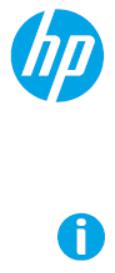
User Guide
HP Laser 103 series
HP Laser 107 series
HP Laser 108 series
www.hp.com/support/laser100

Copyright and License
© Copyright 2019 HP Development Company, L.P.
Reproduction, adaptation, or translation without prior written permission is prohibited, except as allowed under the copyright laws.
The information contained herein is subject to change without notice.
The only warranties for HP products and services are set forth in the express warranty statements accompanying such products and services. Nothing herein should be construed as constituting an additional warranty. HP shall not be liable for technical or editorial errors or omissions contained herein.
•Adobe®, Adobe Photoshop®, Acrobat®, and PostScript® are trademarks of Adobe Systems Incorporated.
•Apple and the Apple logo are trademarks of Apple Inc., registered in the U.S. and other countries.
•OS X is a trademark of Apple Inc., registered in the U.S. and other countries.
•AirPrint is a trademark of Apple Inc., registered in the U.S. and other countries.
•iPad is a trademark of Apple Inc., registered in the U.S. and other countries.
•iPad, iPhone, iPod touch, Mac and Mac OS are trademarks of Apple Inc., registered in the U.S and other countries.
•Microsoft® and Windows® are U.S. registered trademarks of Microsoft Corporation.
•All other brand or product names are trademarks of their respective companies or organizations.
REV. 1.00
Copyright and License | 2

Table of contents
Introduction
Key benefits |
6 |
Features by model |
7 |
Useful to know |
8 |
About this user’s guide |
9 |
Safety information |
10 |
Machine overview |
16 |
Control panel overview |
18 |
Turning on the machine |
19 |
Installing the software |
20 |
Learning the Basic
Usage
Machine’s basic settings |
22 |
Media and tray |
23 |
Using a
Network-Connected
Machine
Network setup |
31 |
Installing driver over the network |
33 |
Wireless network setup |
34 |
Using HP Embedded Web Server |
38 |
HP Smart app |
41 |
Printing
Basic print |
46 |
Canceling a print job |
47 |
Opening printing preferences |
48 |
Using a favorite setting |
49 |
Using help |
50 |
Printing features |
51 |
Using HP Easy Printer Manager |
56 |
Using Printer Status programs |
59 |
Maintenance
Ordering supplies and accessories |
62 |
Available supplies |
63 |
Available maintenance parts |
64 |
Storing the toner cartridge |
65 |
Redistributing toner |
66 |
3

Replacing the toner cartridge |
67 |
Cleaning the machine |
68 |
|
|
Troubleshooting
Tips for avoiding paper jams |
72 |
Clearing paper jams |
73 |
Understanding the LEDs |
75 |
A “Low Toner” or “Very Low Toner” message displays in
Supplies information report |
77 |
Paper feeding problems |
78 |
Power and cable connecting problems |
79 |
Solving other problems |
80 |
Solve wireless network problems |
90 |
Appendix
General specifications |
94 |
Print media specifications |
95 |
System requirements |
97 |
4

Introduction
This chapter provides information you need to know before using the machine.
• Key benefits |
6 |
• Features by model |
7 |
• Useful to know |
8 |
• About this user’s guide |
9 |
• Safety information |
10 |
• Machine overview |
16 |
• Control panel overview |
18 |
• Turning on the machine |
19 |
• Installing the software |
20 |
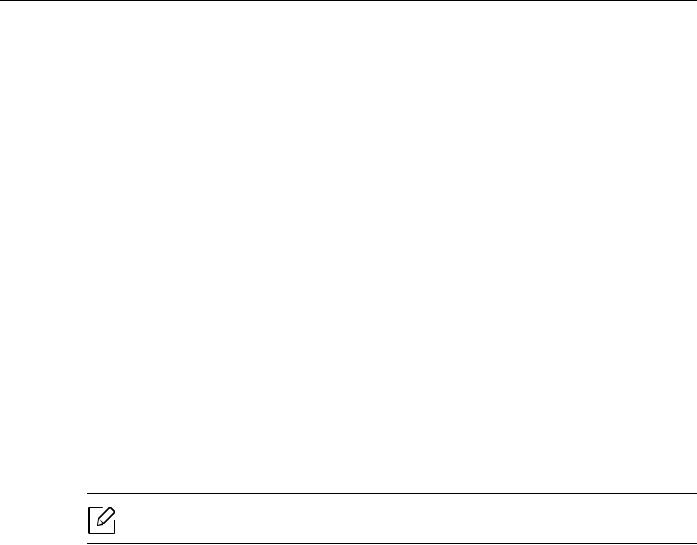
Key benefits
Environmentally friendly
•To save paper, you can print multiple pages on a single sheet of paper.
•To save electricity, this machine automatically conserves electricity by substantially reducing power consumption when not in use.
•We recommend using recycled paper for saving energy.
Convenience
•If you have Internet access, you can get help, support application, machine drivers, manuals, and order information from the HP website (www.hp.com/support/laser100).
Wide range of functionality and application support
•Supports various paper sizes.
•Print watermark: You can customize your documents with words, such as “Confidential”.
•Print posters: The text and pictures of each page of your document are magnified and printed across the multiple sheets of paper and can then be taped together to form a poster.
Supports various wireless network setting method
Wireless networking may not be available depending on the model.
•Using the 

 (Wireless) button
(Wireless) button
-You can easily connect to a wireless network using the 

 (Wireless) button on the machine and the access point (a wireless router).
(Wireless) button on the machine and the access point (a wireless router).
•Using the USB cable
-You can connect and set various wireless network settings using a USB cable.
•Using the Wi-Fi Direct
-You can conveniently print from your mobile device using the Wi-Fi or Wi-Fi Direct feature.
Key benefits | 6

Features by model
Some features and optional goods may not be available depending on model or country.
Operating System
|
|
HP Laser 107a |
HP Laser 107w |
Model/Product number |
|
HP Laser 107r |
|
|
HP Laser 108a |
HP Laser 108w |
|
|
|
||
|
|
HP Laser 103a |
|
Windows |
|
● |
● |
Mac |
|
|
|
Linux |
|
● |
● |
(●: Supported, Blank: Not supported) |
|
|
|
Software
|
|
HP Laser 107a |
HP Laser 107w |
Model/Product number |
|
HP Laser 107r |
|
|
HP Laser 108a |
HP Laser 108w |
|
|
|
||
|
|
HP Laser 103a |
|
Printer driver |
|
● |
● |
HP Easy Printer Manager |
|
● |
● |
Printer Status |
|
● |
● |
HP Embedded Web Server |
|
|
● |
(●: Supported, Blank: Not supported) |
|
|
|
Variety feature
|
HP Laser 107a |
HP Laser 107w |
|
Model/Product number |
HP Laser 107r |
||
HP Laser 108a |
HP Laser 108w |
||
|
|||
|
HP Laser 103a |
|
|
Hi-Speed USB 2.0 |
● |
● |
|
Network Interface Ethernet 10/100 |
|
|
|
Base TX wired LAN |
|
|
|
|
|
|
|
Network Interface 802.11b/g/n |
|
● |
|
wireless LAN |
|
||
|
|
||
|
|
|
|
Wi-Fi Protected Setup™ (WPS) |
|
● |
(●: Supported, Blank: Not supported)
Features by model | 7

Useful to know
Where can I download the machine’s driver?
•Visit www.hp.com/support/laser100 to download the latest machine’s driver, and install it on your system.
Where can I purchase accessories or supplies?
•Inquire at a HP distributor or your retailer.
•Visit the HP website (https://store.hp.com/). You can view product service information.
The attention LED flashes or remains constantly on.
•Turn the product off and on again.
•Check the meanings of LED indications in this manual and troubleshoot accordingly (see "Understanding the LEDs" on page 75).
A paper jam has occurred.
•Open and close the top cover (see "Front view" on page 17).
•Check the instructions on removing jammed paper in this manual and troubleshoot accordingly (see "Clearing paper jams" on page 73).
Printouts are blurry.
•The toner level might be low or uneven. Shake the toner cartridge.
•Try a different print resolution setting.
•Replace the toner cartridge.
The machine does not print.
•Open the print queue list and remove the document from the list (see "Canceling a print job" on page 47).
•Remove the driver and install it again (see "Installing the software" on page 20).
•Select your machine as your default machine in your Windows.
Useful to know | 8
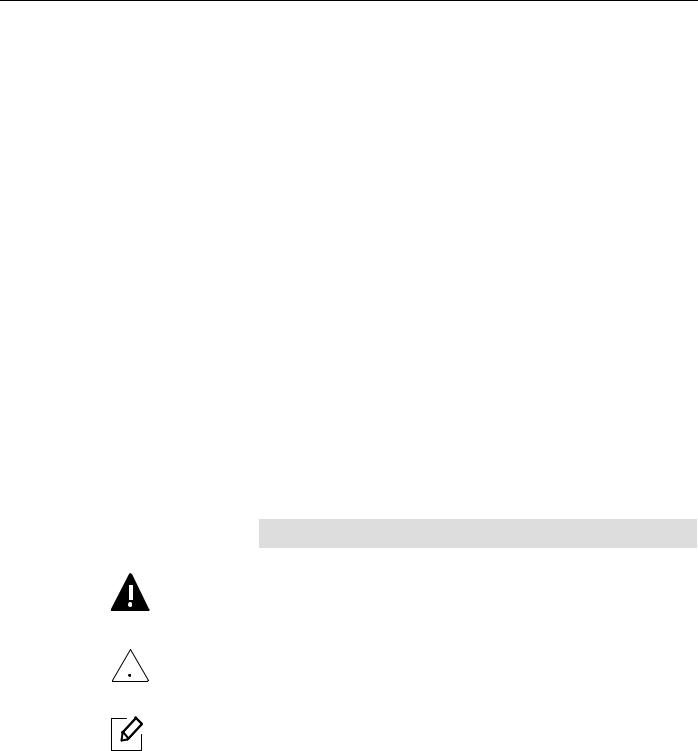
About this user’s guide
This user's guide provides information for your basic understanding of the machine as well as detailed steps to explain machine usage.
•Do not discard this manual, and keep it for future reference.
•Read the safety information before using the machine.
•If you have a problem using the machine, refer to the troubleshooting chapter.
•Terms used in this user’s guide are explained in the glossary chapter.
•All illustrations in this user’s guide may differ from your machine depending on its options or model you purchased.
•The screenshots in this user's guide may differ from your machine depending on the machine’s firmware/driver version.
•The procedures in this user’s guide are mainly based on Windows 7.
Conventions
Some terms in this guide are used interchangeably, as below:
•Document is synonymous with original.
•Paper is synonymous with media, or print media.
•Machine refers to printer or MFP.
General icons
Icon |
Text |
Description |
|
|
|
|
|
|
|
Warning |
Used to alert users to the possibility of personal injury. |
|
|
|
|
|
|
Caution |
Gives users information to protect the machine from possible |
|
|
mechanical damage or malfunction. |
|
|
|
|
|
|
|
|
|
|
|
Note |
Provides additional information or detailed specification of the |
|
|
machine function and feature. |
|
|
|
|
|
|
|
|
|
About this user’s guide | 9
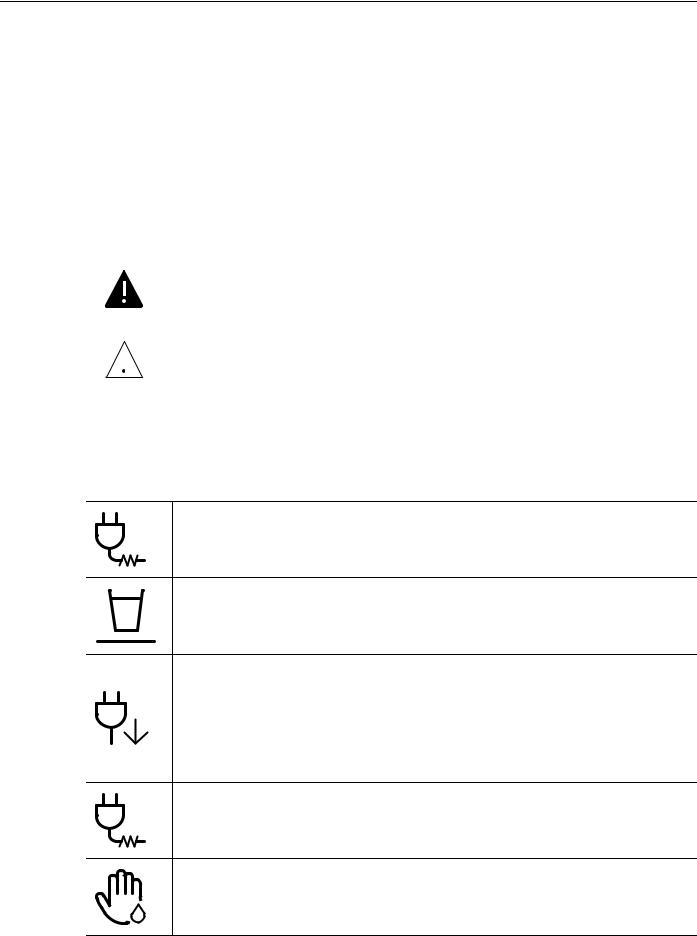
Safety information
These warnings and precautions are included to prevent injury to you and others, and to prevent any potential damage to your machine. Be sure to read and understand all of these instructions before using the machine. After reading this section, keep it in a safe place for future reference.
Important safety symbols
Explanation of all icons and signs used in this chapter
|
|
Warning |
Hazards or unsafe practices that may result in severe personal injury |
|
|
or death. |
|
|
|
|
|
|
|
|
|
|
|
Caution |
Hazards or unsafe practices that may result in minor personal injury |
|
|
or property damage. |
|
|
|||
|
|
|
|
|
|
|
|
Operating environment
 Warning
Warning
Do not use if the power cord is damaged or if the electrical outlet is not grounded.
This could result in electric shock or fire.
Do not place anything on top of the machine (water, small metal or heavy objects, candles, lit cigarettes, etc.).
This could result in electric shock or fire.
• If the machine gets overheated, it releases smoke, makes strange noises, or generates an odd odor, immediately turn off the power switch and unplug the machine.
•The user should be able to access the power outlet in case of emergencies that might require the user to pull the plug out.
This could result in electric shock or fire.
Do not bend, or place heavy objects on the power cord.
Stepping on or allowing the power cord to be crushed by a heavy object could result in electric shock or fire.
Do not remove the plug by pulling on the cord; do not handle the plug with wet hands.
This could result in electric shock or fire.
Safety information | 10
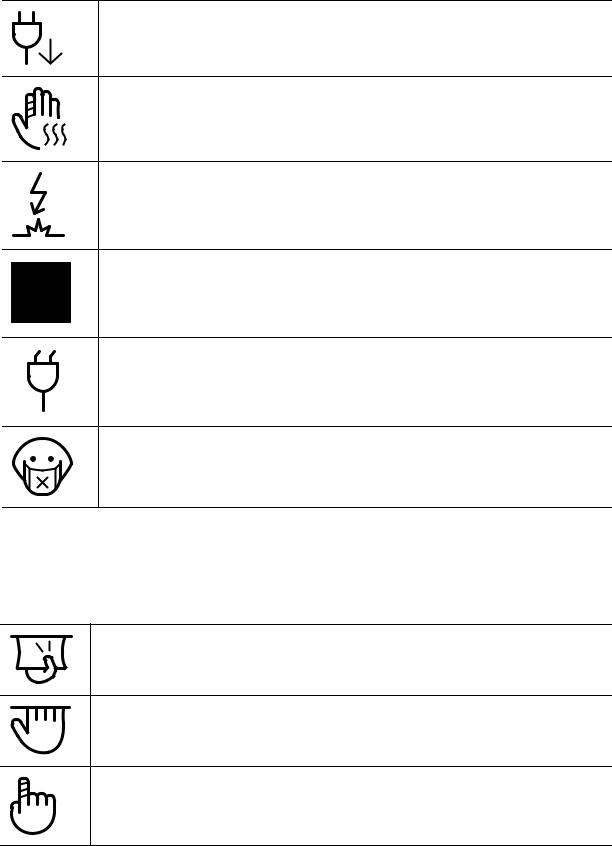
 Caution
Caution
During an electrical storm or for a period of non-operation, remove the power plug from the electrical outlet.
This could result in electric shock or fire.
Be careful, the paper output area is hot.
Burns could occur.
If the machine has been dropped, or if the cabinet appears damaged, unplug the machine from all interface connections and request assistance from qualified service personnel.
Otherwise, this could result in electric shock or fire.
If the machine does not operate properly after these instructions have been followed, unplug the machine from all interface connections and request assistance from qualified service personnel.
Otherwise, this could result in electric shock or fire.
If the plug does not easily enter the electrical outlet, do not attempt to force it in.
Call an electrician to change the electrical outlet, or this could result in electric shock.
Do not allow pets to chew on the AC power, telephone or PC interface cords. This could result in electric shock or fire and/or injury to your pet.
Operating method
 Caution
Caution
Do not forcefully pull the paper out during printing.
It can cause damage to the machine.
Be careful not to put your hand between the machine and paper tray.
You may get injured.
Be care when replacing paper or removing jammed paper.
New paper has sharp edges and can cause painful cuts.
Safety information | 11
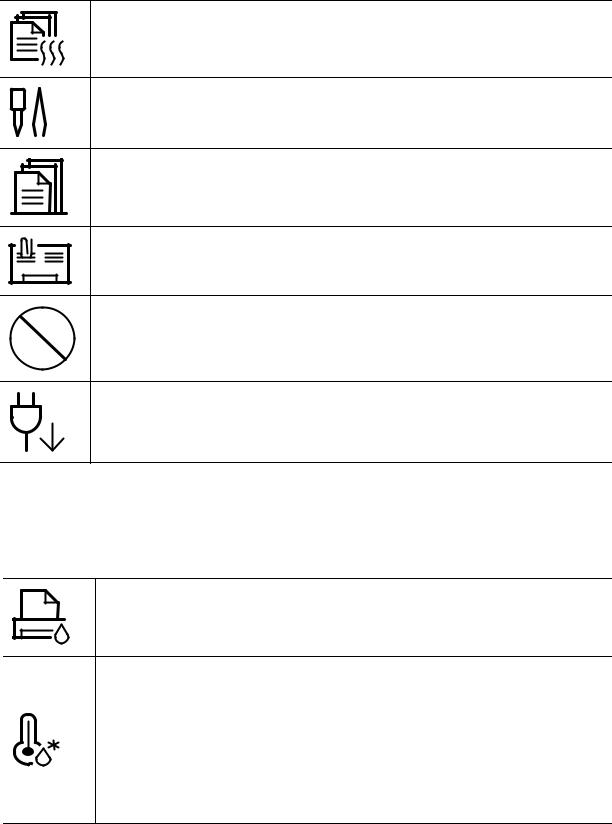
When printing large quantities, the bottom part of the paper output area may get hot. Do not allow children to touch.
Burns can occur.
When removing jammed paper, do not use tweezers or sharp metal objects. It can damage the machine.
Do not allow too many papers to stack up in the paper output tray.
It can damage the machine.
Do not block or push objects into the ventilation opening.
This could result in elevated component temperatures which can cause damage or fire.
Use of controls or adjustments or performance of procedures other than those specified herein may result in hazardous radiation exposure.
This machine's power reception device is the power cord.
To switch off the power supply, remove the power cord from the electrical outlet.
Installation / Moving
 Warning
Warning
Do not place the machine in an area with dust, humidity, or water leaks. This could result in electric shock or fire.
Place the machine in the environment where it meets the operating temperature and humidity specification.
Do not use the machine when it is below freezing temperature or has recently been moved from a location below freezing temperature. Doing so may damage the machine. Only operate the machine when the internal temperature of the machine is within the operating temperature and humidity specifications.
Otherwise, quality problems can occur and cause damage to the machine. See "General specifications" on page 94.
Safety information | 12
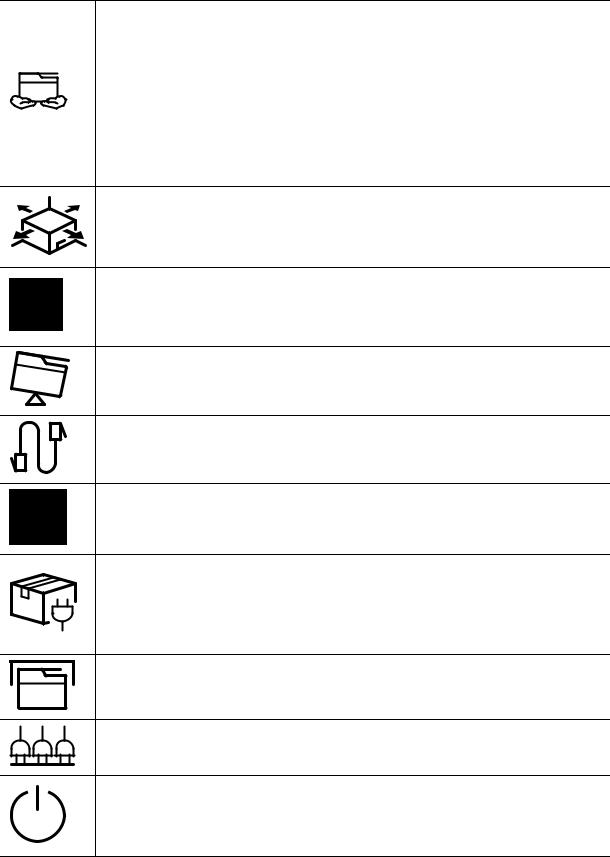
 Caution
Caution
Before moving the machine, turn the power off and disconnect all cords. The information below are only suggestions based on the units weight.If you have a medical condition that prevents you from lifting, do not lift the machine. Ask for help, and always use the appropriate amount of people to left the device safety.
Then lift the machine:
• If the machine weighs under 20 kg (44.09 lbs), lift with 1 person.
•If the machine weighs 20 kg (44.09 lbs) - 40kg (88.18 lbs), lift with 2 people.
•If the machine weighs more than 40 kg (88.18 lbs), lift with 4 or more people. The machine could fall, causing injury or machine damage.
Choose a flat surface with enough space for ventilation to place the machine. Also consider the space required to open the cover and trays.
The place should be well-ventilated and be far from direct light, heat, and humidity.
When using the machine for a long period of time or printing a large number of pages in a non-ventilated space, it could pollute the air and be harmful to your health. Place the machine in a well-ventilated space or open a window to circulate the air periodically.
Do not place the machine on an unstable surface.
The machine could fall, causing injury or machine damage.
Use only No.26 AWGa or larger, telephone line cord, if necessary.
Otherwise, it can cause damage to the machine.
Make sure you plug the power cord into a grounded electrical outlet.
Otherwise, this could result in electric shock or fire.
Use the power cord supplied with your machine for safe operation. If you are using a cord which is longer than 2 meters (6 feet) with a 110 V machine, then the gauge should be 16 AWG or larger.
Otherwise, it can cause damage to the machine, and could result in electric shock or fire.
Do not put a cover over the machine or place it in an airtight location, such as a closet.
If the machine is not well-ventilated, this could result in fire.
Do not overload wall outlets and extension cords.
This can diminish performance, and could result in electric shock or fire.
The machine should be connected tothe power level which is specified on the label.
If you are unsure and want to check the power level you are using, contact the electrical utility company.
a.AWG: American Wire Gauge
Safety information | 13
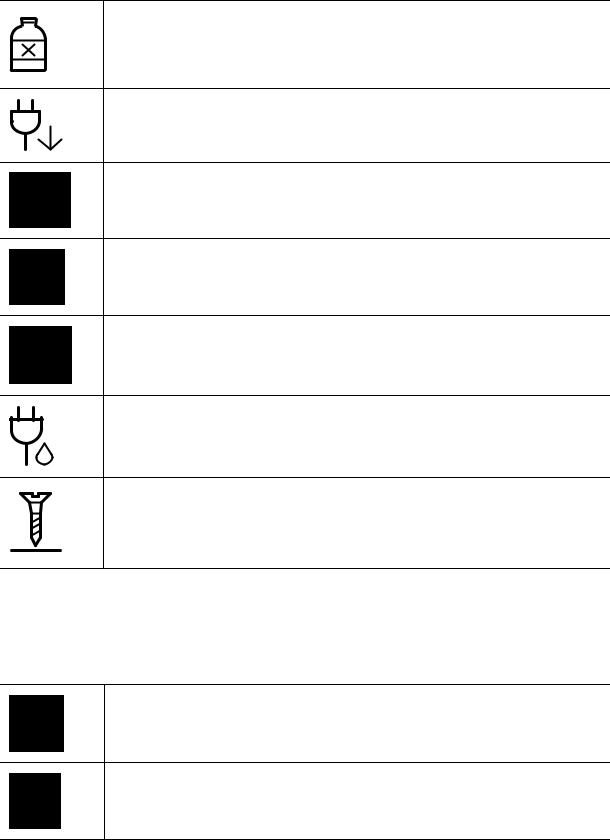
Maintenance / Checking
 Caution
Caution
Unplug this product from the wall outlet before cleaning the inside of the machine. Do not clean the machine with benzene, paint thinner or alcohol; do not spray water directly into the machine.
This could result in electric shock or fire.
When you are working inside the machine replacing supplies or cleaning the inside, do not operate the machine.
You could get injured.
Keep cleaning supplies away from children.
Children could get hurt.
Do not disassemble, repair or rebuild the machine by yourself.
It can damage the machine. Call a certified technician when the machine needs repairing.
To clean and operate the machine, strictly follow the user's guide provided with the machine.
Otherwise, you could damage the machine.
Keep the power cable and the contact surface of the plug clean from dust or water.
Otherwise, this could result in electric shock or fire.
• Do not remove any covers or guards that are fastened with screws.
• Fuser units should only be repaired by a certified service technician. Repair by non-certified technicians could result in fire or electric shock.
• The machine should only be repaired by a HP service technician.
Supply usage
 Caution
Caution
Do not disassemble the toner cartridge.
Toner dust can be dangerous if inhaled or ingested.
Do not burn any of the supplies such as toner cartridge or fuser unit.
This could cause an explosion or uncontrollable fire.
Safety information | 14
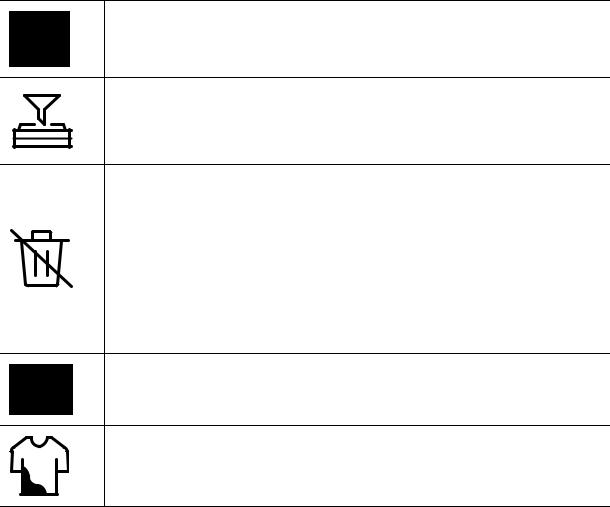
When storing supplies such as toner cartridges, keep them away from children.
Toner dust can be dangerous if inhaled or ingested.
Using recycled supplies, such as toner, can cause damage to the machine.
In case of damage due to the use of recycled supplies, a service fee will be charged.
For supplies that contain toner dust (toner cartridge, waste toner bottle, imaging unit, etc.) follow the instructions below.
•When disposing of the supplies, follow the instructions for disposal. Refer to the reseller for disposal instructions.
•Do not wash the supplies.
•For a waste toner bottle, do not reuse it after emptying the bottle.
If you do not follow the instructions above, it may cause machine malfunction and environmental pollution. The warranty does not cover damages caused by a user's carelessness.
When toner gets on your clothing, do not use hot water to wash it. Hot water sets toner into fabric. Use cold water.
When changing the toner cartridge or removing jammed paper, be careful not to let toner dust touch your body or clothes.
Toner dust can be dangerous if inhaled or ingested.
Safety information | 15
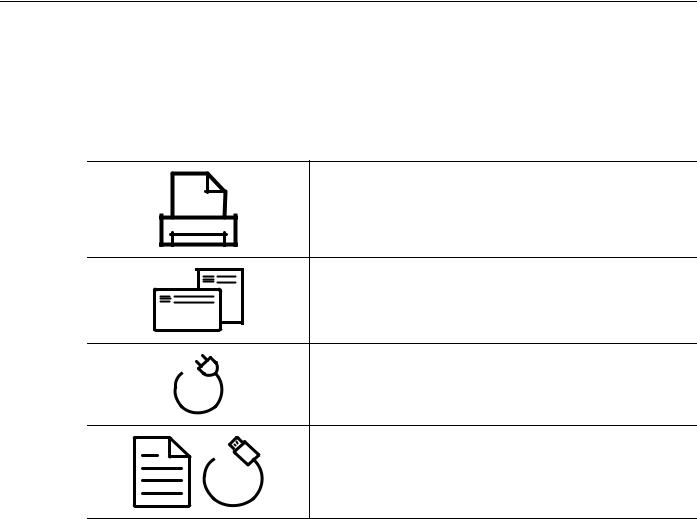
Machine overview
Components
The actual component may differ from the illustration below. Some components may change depending on the circumstances.
Machinea
Setup guide and Reference guide
Power cord
Misc. accessoriesb
a.This illustration may differ from your machine depending on your model. There are various types of machine.
b.Miscellaneous accessories included with your machine may vary by country of purchase and specific model.
Machine overview | 16
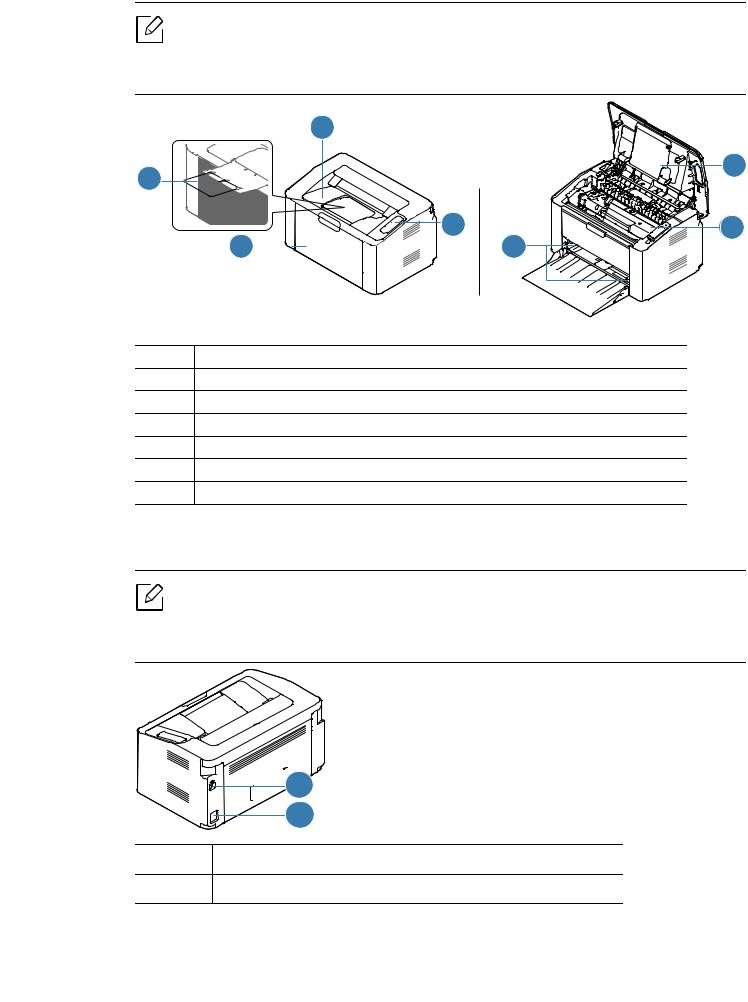
Front view
• This illustration may differ from your machine depending on its model.
•Some features and optional goods may not be available depending on model or country (see "Features by model" on page 7).
1 |
|
4 |
5 |
|
|
2 |
6 |
3 |
7 |
1Output tray
2Control panel
3Tray
4Output support
5Top cover
6Toner cartridge
7Paper width guide
Rear view
• This illustration may differ from your machine depending on its model.
•Some features and optional goods may not be available depending on model or country (see "Features by model" on page 7).

 1 2
1 2
1USB port
2Power receptacle
Machine overview | 17
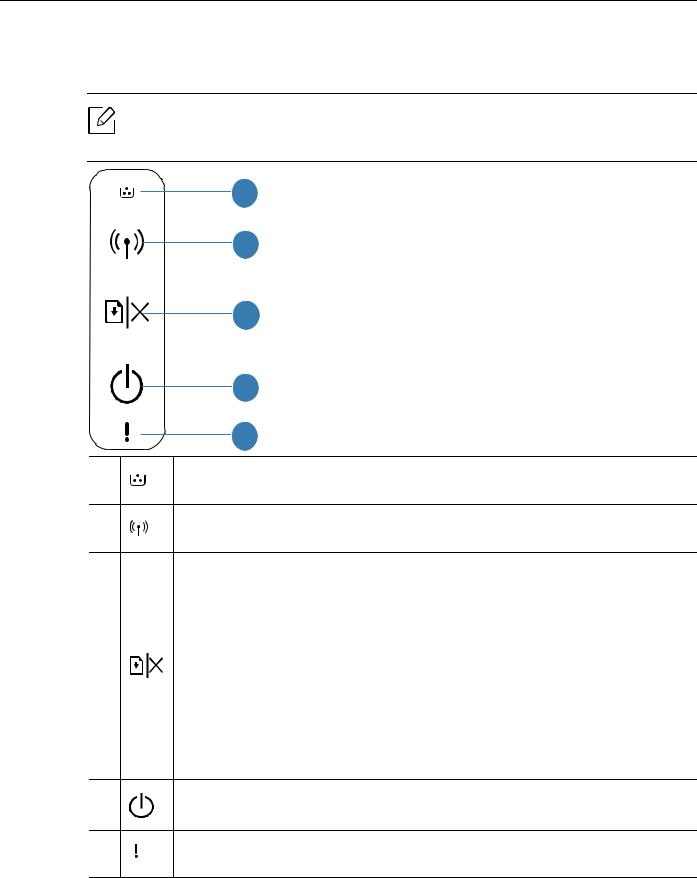
Control panel overview
This control panel may differ from your machine depending on its model. There are various types of control panels.
1
2
3
4
5
1
2
3
4
5
Toner LED |
Shows the status of the toner (see "Toner LED/ Wireless LED/ |
|
Power LED" on page 75). |
||
|
||
Wireless |
Configures the wireless network connection easily without a |
|
computer (see "Wireless network setup" on page 34). |
||
|
||
|
• Configuration sheet & Network Configuration sheet |
|
|
- Press and hold this button for about 10 seconds until the |
|
|
power LED blinks slowly, and release. |
|
|
• Prints supplies info report / error report |
|
Resume/Can |
- Press and hold this button for about 15 seconds until the |
|
power LED blinks rapidly, and release. |
||
cel |
||
• Cancel print |
||
|
||
|
- Press this button during printing job. |
|
|
• Manual print |
|
|
- Press this button to print the other side of all pages if you |
|
|
have selected Double-sided Printing (Manual) in your driver. |
|
Power |
• You can turn the power on or off. |
|
• You can wake the machine up from the sleep mode. |
||
|
||
Attention |
Shows the attention of your machine (see "Attention LED" on |
|
LED |
page 75). |
|
|
|
Control panel overview | 18
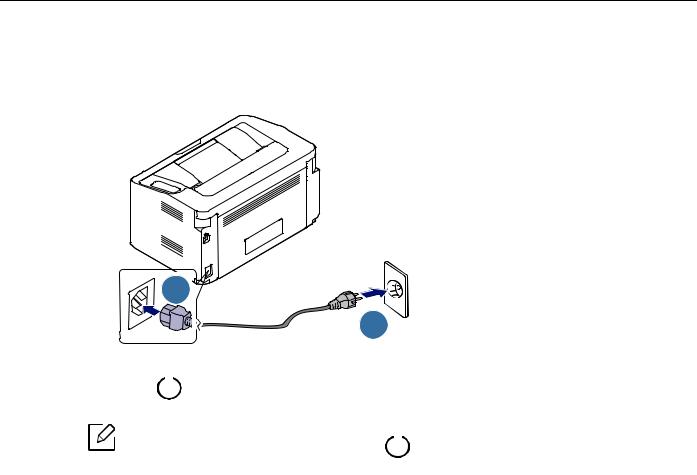
Turning on the machine
1 Connect the machine to the electricity supply first.
1
2
2 Press |
|
(power) on the control panel. |
|
|
|
|
|
||
|
|
|
||
|
|
|
|
|
If you want to turn the power off, press |
|
(power) on the control panel. |
||
|
||||
|
||||
|
|
|
|
|
Turning on the machine | 19
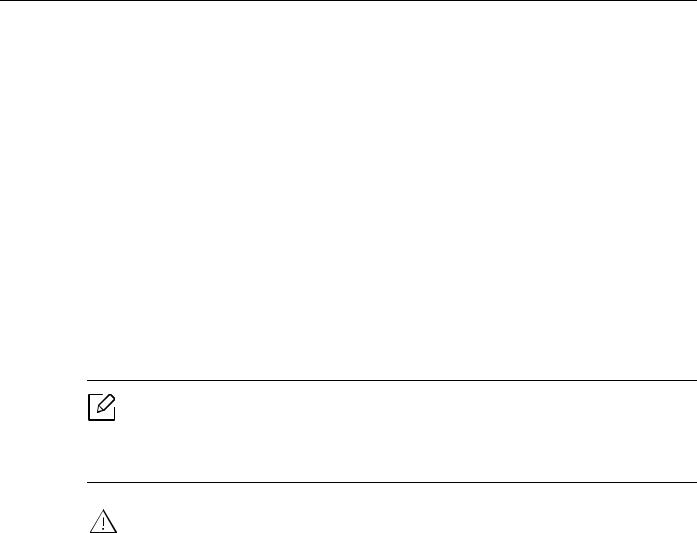
Installing the software
After you have set up your machine and connected it to your computer, you must install the printer software. You need to download software packages from the HP website to install the printer software.
Before installing, check whether your computer’s OS support the software (see "Operating System" on page 7).
For HP's all-inclusive help for the printer, go to www.hp.com/support/laser100. Find the following support:
•Install and configure
•Learn and use
•Solve problems
•Download software and firmware updates
•Join support forums
•Find warranty and regulatory information
A locally connected machine is a machine directly attached to your computer using the cable. If your machine is attached to a network, skip the following steps below and go on to installing a network connected machine’s driver (see "Installing driver over the network" on page 33).
Only use a USB cable no longer then 3 meters (118 inches).
Installing the software | 20

Learning the Basic
Usage
After installation is complete, you may want to set the machine’s default settings. Refer to the next section if you would like to set or change values.
• Machine’s basic settings |
22 |
• Media and tray |
23 |

Machine’s basic settings
After installation is complete, you may want to set the machine's default settings.
Machine’s default settings
You change the machine’s setting set in the machine from HP Easy Printer Manager or HP Embedded Web Server.
•If your machine is connected to the local, you can set the machine’s setting from HP Easy Printer Manager > Advanced Setting > Device Settings (see "Using HP Easy Printer Manager" on page 56).
•If your machine is connected to the network, you can set the machine’s setting from HP Embedded Web Server > Settings tab > Machine Settings (see "Using HP Embedded Web Server" on page 38).
Altitude adjustment
Print quality is affected by atmospheric pressure, which is determined by the height of the machine above sea level. The following information will guide you on how to set your machine for the best print quality.
Before you set the altitude value, determine the altitude where you are.
•Normal: 0 ~ 1,000 m (3,280 ft)
•High 1 : 1,000 m (3,280 ft) ~ 2,000 m (6,561 ft)
•High 2: 2,000 m (6,561 ft) ~ 3,000 m (9,842 ft)
•High 3: 3,000 m (9,842 ft) ~ 4,000 m (13,123 ft)
•High 4: 4,000 m (13,123 ft) ~ 5,000 m (16,404 ft)
You can set the altitude value from HP Easy Printer Manager or HP Embedded Web Server.
•If your machine is connected to the local, you can set the machine’s setting from HP Easy Printer Manager > Advanced Setting > Device Settings (see "Using HP Easy Printer Manager" on page 56).
•If your machine is connected to the network, you can set the machine’s setting from HP Embedded Web Server > Settings tab > Machine Settings (see "Using HP Embedded Web Server" on page 38).
Machine’s basic settings | 22
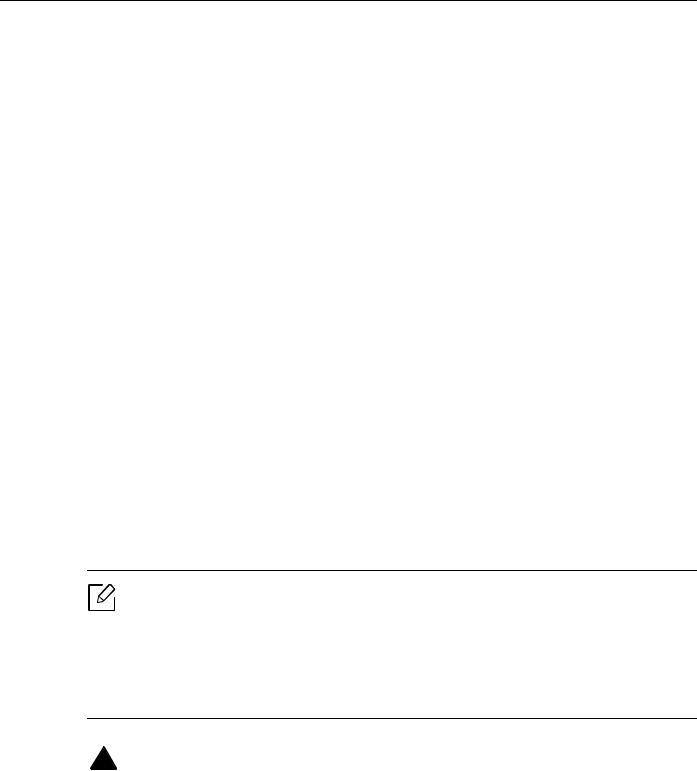
Media and tray
This chapter provides information on how to load print media into your machine.
Selecting print media
You can print on a variety of print media, such as plain paper, envelopes, labels, and transparencies. Always use print media that meets the guidelines for use with your machine.
Guidelines for select the print media
Print media that does not meet the guidelines outlined in this user’s guide may cause the following problems:
•Poor print quality
•Increased paper jams
•Premature wear on the machine.
Properties, such as weight, composition, grain, and moisture content, are important factors that affect the machine’s performance and the output quality. When you choose print materials, consider the following:
•The type, size, and weight of the print media for your machine are described in print media specifications (see "Print media specifications" on page 95).
•Desired outcome: The print media you choose should be appropriate for your project.
•Brightness: Some print media are whiter than others and produce sharper, more vibrant images.
•Surface smoothness: The smoothness of the print media affects how crisp the printing looks on the paper.
• Some print media may meet all of the guidelines in this user’s guide and still not produce satisfactory results. This may be the result of the sheets characteristics, improper handling, unacceptable temperature and humidity levels, or other variables over which cannot be controlled.
•Before purchasing large quantities of print media, ensure that it meets the requirements specified in this user’s guide.
•Using print media that does not meet these specifications may cause problems or require repairs. Such repairs are not covered by HP’s warranty or service agreements.
•The amount of paper put into the tray may differ according to media type used (see "Print media specifications" on page 95).
•Make sure not to use the inkjet photo paper with this machine. It could cause damage to the machine.
•Using flammable print media can cause a fire.
•Use designated print media (see "Print media specifications" on page 95).
Media and tray | 23
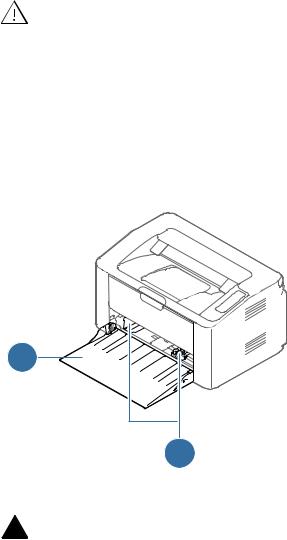
The use of flammable media or foreign materials left in the printer may lead to overheating of the unit and, in rare cases may cause a fire.
The amount of paper put into the tray may differ according to media type used (see "Print media specifications" on page 95).
Tray overview
To change the size, you need to adjust the paper guide.
2
1 |
1. Paper width guide |
|
2. Tray |
If you do not adjust the guide, it may cause paper registration, image skew, or jamming of the paper.
Media and tray | 24
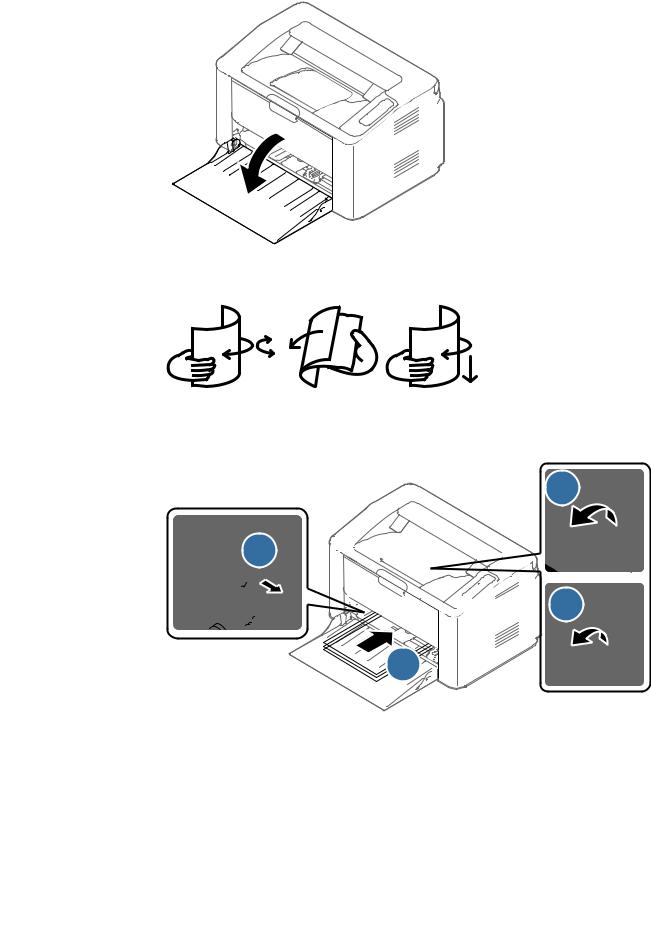
Loading paper in the tray
1 Open the tray.
2 Flex or fan the edge of the paper stack to separate the pages before loading papers.
3 Adjust the tray size to the media size you are loading (see "Tray overview" on page 24). Then place the paper with the side you want to print facing up and open the output tray.


 3
3




















 1
1 

















































 4
4











2 
4 Squeeze the paper width guide and slide it to the edge of the paper stack without causing it to bend.
Media and tray | 25
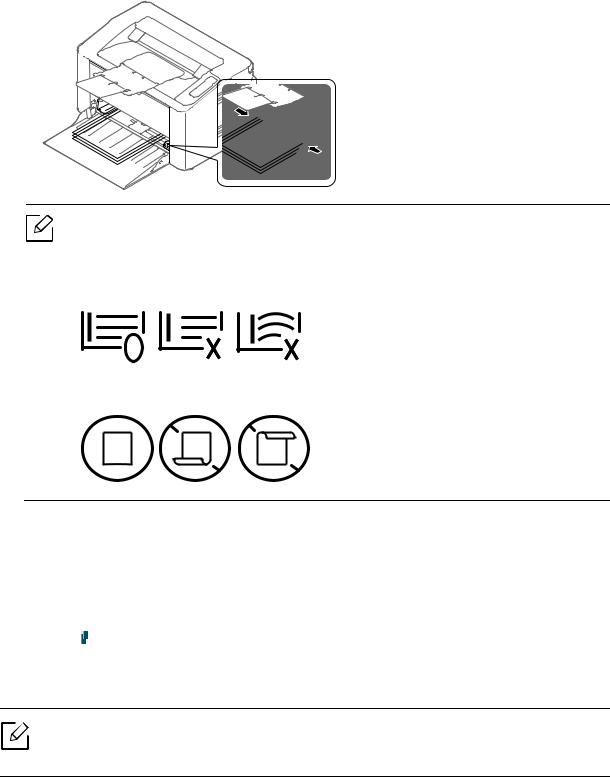
• If you do not adjust the guide, it may cause paper registration, image skew, or jamming of the paper.
•Do not push the paper width guide too far causing the media to warp.
•If you do not adjust the paper width guide, it may cause paper jams.
•Do not use a paper with a leading-edge curl, it may cause a paper jam or the paper can be wrinkled.
5 When you print a document, set the paper type and size for the tray (see "Setting the paper size and type" on page 29).
Printing on special media
The table below shows the special media usable in tray.
To change the paper setting set in the machine, from the Printing preferences window > Paper tab > Paper Type (see "Opening printing preferences" on page 48).
When using special media, we recommend you feed one sheet at a time (see "Print media specifications" on page 95).
To see for paper weights for each sheet, refer to "Print media specifications" on page 95.
Types |
Tray |
|
|
|
|
Plain |
● |
|
|
|
|
Heavy 90-120 g |
● |
|
|
|
|
Light 60-69 g |
● |
|
|
|
|
|
Media and tray | 26 |
|
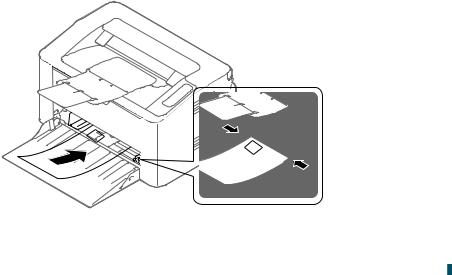
Types |
Tray |
|
|
Bond |
● |
|
|
Color |
● |
|
|
Extra Heavy 121-163 g |
● |
|
|
Labels |
● |
|
|
Envelope |
● |
|
|
Preprinted |
● |
|
|
Recycled |
● |
|
|
(●: Supported)
Envelope
Printing successfully on envelopes depends upon the quality of the envelopes. To print an envelope, place it as shown in the following figure.
If you select Envelope from the Printing Preferences window, but the printed images get easily erased, select envelope size and try printing again. However, this might cause some noise when printing. 

•When selecting envelopes, consider the following factors:
-Weight: should not exceed 90 g/m2 otherwise; jams may occur.
-Construction: should lie flat with less than 6 mm curl and should not contain air.
-Condition: should not be wrinkled, nicked, nor damaged.
-Temperature: should resist the heat and pressure of the machine during operation.
•Use only well-constructed envelopes with sharp and well-creased folds.
•Do not use stamped envelopes.
•Do not use envelopes with clasps, snaps, windows, coated lining, self-adhesive seals, or other synthetic materials.
•Do not use damaged or poorly made envelopes.
•Be sure the seam at both ends of the envelope extends all the way to the corner of the envelope.
Media and tray | 27
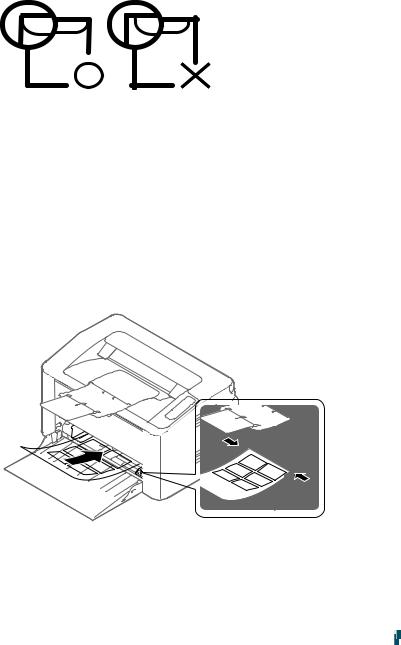
•Envelopes with a peel-off adhesive strip or with more than one flap that folds over to seal must use adhesives compatible with the machine’s fusing temperature for 0.1 second (about 170°C (338 °F)). The extra flaps and strips might cause wrinkling, creasing, or jams, and may even damage the fuser.
•For the best print quality, position margins no closer than 15 mm from the edges of the envelope.
•Avoid printing over the area where the envelope’s seams meet.
Labels
To avoid damaging the machine, use only labels designed for use in laser printers.
•When selecting labels, consider the following factors:
-Adhesives: Should be stable at your machine’s fusing temperature. Check your machine’s specifications to view the fusing temperature (about 170°C (338°F)).
-Arrangement: Only use labels with no exposed backing between them. Labels can peel off sheets that have spaces between the labels, causing serious jams.
-Curl: Must lie flat with no more than 13 mm of curl in any direction.
-Condition: Do not use labels with wrinkles, bubbles, or other indications of separation.
•Make sure that there is no exposed adhesive material between labels. Exposed areas can cause labels to peel off during printing, which can cause paper jams. Exposed adhesive can also cause damage to machine components.
•Do not run a sheet of labels through the machine more than once. The adhesive backing is designed for only a single pass through the machine.
•Do not use labels that are separating from the backing sheet or are wrinkled, bubbled, or otherwise damaged.
Media and tray | 28

Card stock/ Custom-sized paper
•In the software application, set margins at least 6.4 mm (0.25 inches) away from the edges of the material.
Preprinted paper
When loading preprinted paper, the printed side should be facing up with an uncurled edge at the front. If you experience problems with paper feeding, turn the paper around. Note that print quality is not guaranteed.
•Must be printed with heat-resistant ink that will not melt, vaporize, or release hazardous emissions when subjected to the machine’s fusing temperature for 0.1 second (about 170°C (338°F)).
•Preprinted paper ink must be non-flammable and should not adversely affect machine rollers.
•Before you load preprinted paper, verify that the ink on the paper is dry. During the fusing process, wet ink can come off preprinted paper, reducing print quality.
Setting the paper size and type
After loading paper in the paper tray, set the paper size and type.
To change the paper setting set in the machine, from the Printing preferences window > Paper tab > Paper Type (see "Opening printing preferences" on page 48).
If you want to use special-sized paper such as billing paper, select Custom in the Paper tab in the Printing Preferences (see "Opening printing preferences" on page 48).
Media and tray | 29

Using a Network-Connected
Machine
This chapter gives you step-by-step instructions for setting up a network connected machine and software.
Supported optional devices and features may differ according to your model (see "Features by model" on page 7).
• Network setup |
31 |
• Installing driver over the network |
33 |
• Wireless network setup |
34 |
• Using HP Embedded Web Server |
38 |
• HP Smart app |
41 |
